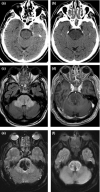A fatal case of COVID-19-associated acute necrotizing encephalopathy
- PMID: 34655265
- PMCID: PMC8653160
- DOI: 10.1111/ene.14966
A fatal case of COVID-19-associated acute necrotizing encephalopathy
Abstract
Introduction: An increasing number of published reports on SARS-CoV-2 neurological manifestations have revealed a wide spectrum of symptoms, diagnostic features, and outcomes. We report a fatal case of a COVID-19-associated acute necrotizing encephalopathy (ANE).
Case report: We report a 70-year-old man brought to the hospital after a generalized tonic-clonic seizure. He was confused and disoriented. Nasopharyngeal swab testing for SARS-CoV-2 was positive. A head computed tomography (CT) scan and cerebrospinal fluid (CSF) analysis showed no signs of acute pathology. After recurrent seizures, he was sedated and intubated. Throughout the days that followed he remained in a therapeutic coma. After discontinuation of sedatives, he remained unconscious. A repeated head CT scan showed signs of pontine edema, and brain magnetic resonance imaging (MRI) revealed inhomogeneous hyperintensities with microhemorrhages and small autonecrotic cavities in both thalami, brain stem, and cerebellar peduncles. With a high suspicion of a COVID-19-associated ANE, the patient was started on high-dose glucocorticoids; however, he died the next day. The CSF tested negative for SARS-CoV-2.
Discussion: A variety of COVID-19 neurological manifestations have been reported to date, including various forms of encephalitis and encephalopathy. In our patient, encephalopathy with seizures was the presenting symptom of SARS-CoV-2 infection. The radiological findings on days 8 and 9 were consistent with an ANE. The precise pathogenesis of ANE remains unclear; however, an immune-mediated mechanism is suspected. Early diagnostics with prompt administration of immunomodulators may be lifesaving. Suspicion of a COVID-19-related encephalopathy/encephalitis should be raised in all patients with altered mental status, seizures, and/or coma.
Keywords: COVID-19; SARS-CoV-2; necrotizing encephalopathy; neurological manifestations.
© 2021 European Academy of Neurology.
Conflict of interest statement
None.
Figures
Similar articles
-
Defining the Clinicoradiologic Syndrome of SARS-CoV-2 Acute Necrotizing Encephalopathy: A Systematic Review and 3 New Pediatric Cases.Neurol Neuroimmunol Neuroinflamm. 2024 Jan;11(1):e200186. doi: 10.1212/NXI.0000000000200186. Epub 2023 Dec 7. Neurol Neuroimmunol Neuroinflamm. 2024. PMID: 38086061 Free PMC article.
-
Myoclonus status revealing COVID 19 infection.Seizure. 2023 Jan;104:12-14. doi: 10.1016/j.seizure.2022.11.010. Epub 2022 Nov 22. Seizure. 2023. PMID: 36446232 Free PMC article.
-
Fatal Acute Necrotizing Encephalopathy in a 17-Year-Old Girl with COVID-19: A Case Report.Am J Case Rep. 2025 May 1;26:e946932. doi: 10.12659/AJCR.946932. Am J Case Rep. 2025. PMID: 40308025 Free PMC article.
-
SARS-CoV-2-Associated Acute Hemorrhagic, Necrotizing Encephalitis (AHNE) Presenting with Cognitive Impairment in a 44-Year-Old Woman without Comorbidities: A Case Report.Am J Case Rep. 2020 Aug 16;21:e925641. doi: 10.12659/AJCR.925641. Am J Case Rep. 2020. PMID: 32799213 Free PMC article.
-
Acute hemorrhagic leukoencephalitis in a COVID-19 patient-a case report with literature review.Neuroradiology. 2021 May;63(5):653-661. doi: 10.1007/s00234-021-02667-1. Epub 2021 Feb 11. Neuroradiology. 2021. PMID: 33575849 Free PMC article. Review.
Cited by
-
COVID-19-Associated Encephalopathy-Case Series and Clinical Considerations.J Clin Med. 2022 Feb 13;11(4):981. doi: 10.3390/jcm11040981. J Clin Med. 2022. PMID: 35207253 Free PMC article.
-
Defining the Clinicoradiologic Syndrome of SARS-CoV-2 Acute Necrotizing Encephalopathy: A Systematic Review and 3 New Pediatric Cases.Neurol Neuroimmunol Neuroinflamm. 2024 Jan;11(1):e200186. doi: 10.1212/NXI.0000000000200186. Epub 2023 Dec 7. Neurol Neuroimmunol Neuroinflamm. 2024. PMID: 38086061 Free PMC article.
-
MRI Findings of COVID-19 Associated Acute Necrotizing Encephalopathy in Two Pediatric Patients: Case Report and Literature Review.J Korean Soc Radiol. 2024 May;85(3):682-690. doi: 10.3348/jksr.2023.0023. Epub 2024 May 14. J Korean Soc Radiol. 2024. PMID: 38873375 Free PMC article.
-
Recurrent infection triggered encephalopathy syndrome in a pediatric patient with RANBP2 mutation and severe acute respiratory syndrome coronavirus 2 infection.Pediatr Investig. 2023 Nov 19;7(4):290-296. doi: 10.1002/ped4.12406. eCollection 2023 Dec. Pediatr Investig. 2023. PMID: 38050538 Free PMC article.
-
Acute Necrotizing Encephalopathy in Adult Patients With COVID-19: A Systematic Review of Case Reports and Case Series.J Clin Neurol. 2023 Nov;19(6):597-611. doi: 10.3988/jcn.2022.0431. Epub 2023 Jul 13. J Clin Neurol. 2023. PMID: 37455513 Free PMC article.
References
Publication types
MeSH terms
LinkOut - more resources
Full Text Sources
Medical
Miscellaneous


